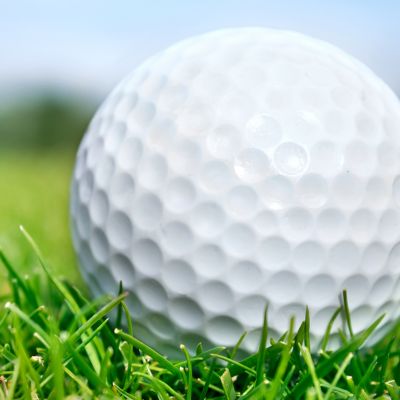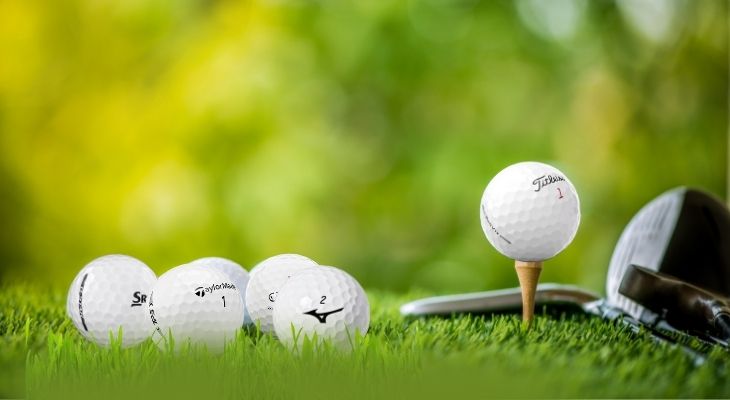Understanding the Composition of a Typical Golf Ball

Golfers are constantly striving to improve their game and enhance their swing technique. One effective way to achieve this is by gaining a deeper understanding of the golf ball. It may come as a surprise, but there’s more to a golf ball than what meets the eye. For years, golfers have been hitting those small, white balls without truly knowing what’s inside them. The reality is that a golf ball is a carefully crafted object with various components that significantly impact its performance. One crucial aspect that often goes unnoticed is the composition of the ball itself. By familiarizing ourselves with the materials that make up a golf ball and how they influence its flight, we can make a significant difference in our game. Let’s explore the composition of a typical golf ball and uncover the secrets behind these amazing objects that help us hit our shots impressively far down the fairway.
Basics of a Golf Ball
When it comes to understanding the composition of a golf ball, it’s essential to familiarize yourself with the basic components that make up its structure.

Core
The design of the core, the central component of a golf ball, can vary depending on the ball’s intended characteristics. Core design influences factors such as compression, energy transfer, and launch conditions.
The core design, along with compression, impacts the ball’s initial velocity, launch angle, and overall distance. Higher-compression cores are often used in golf balls designed for faster swing speeds, while lower-compression cores are suitable for slower swing speeds.
Layer
Layer, located between the core and cover, helps optimize energy transfer, spin rates, and overall ball performance. Similar to the core, the intermediate layer is formed by melting and molding the appropriate material into the desired shape.
Cover
The cover of a golf ball forms the outermost layer and directly impacts its control, spin, and durability. The two primary cover materials used in golf balls are Surlyn and urethane.
Surlyn covers are known for their durability and resistance to cuts and scuffs. Golf balls with Surlyn covers tend to provide longer distances, making them popular choices for golfers seeking maximum distance off the tee. However, they may sacrifice some feel and control around the greens.
Urethane covers, on the other hand, offer superior control and spin. Golf balls with urethane covers provide a softer feel upon impact and generate more backspin, allowing for better greenside control and shot-stopping ability. These balls are often preferred by skilled golfers who prioritize control and precision over sheer distance.
Dimples
The dimples on a golf ball might seem like mere aesthetic features, but they play a crucial role in the ball’s flight characteristics. Dimples are designed to create turbulence in the airflow around the ball, reducing drag and maximizing lift. This allows the ball to achieve a longer, more stable flight.
The number, size, and pattern of dimples can vary among different golf ball models. Golf ball manufacturers carefully engineer these dimple designs to optimize lift and minimize drag, ensuring the ball’s flight remains consistent and predictable.
Design Features of a Golf Ball
The design features of a golf ball are essential considerations when it comes to its performance characteristics. Manufacturers employ various design elements to optimize distance, control, spin, and overall playability. Let’s explore some key design features of a golf ball:
Dimple Pattern, Number, and Depth

Dimples are one of the most recognizable design features of a golf ball. These small indentations on the surface create turbulence in the airflow around the ball, reducing drag and maximizing lift. The dimple pattern, number, and depth significantly influence the ball’s aerodynamic properties.
Different golf ball models have varying dimple patterns and configurations. Common dimple patterns include circular, hexagonal, or a combination of both. The number of dimples can range from around 300 to 500 or more. Dimple depth also varies, with deeper dimples potentially providing enhanced aerodynamic performance.
Manufacturers carefully engineer the dimple design to optimize lift and minimize drag, resulting in a more consistent and predictable ball flight. The specific dimple pattern and arrangement can impact how the ball performs in terms of distance, trajectory, and overall stability in flight.
Alignment Aids and Markings

Some golf balls feature alignment aids or distinct markings to help golfers line up their shots and improve accuracy. These design features can consist of alignment lines, arrows, or specific patterns on the ball’s surface. Alignment aids can be particularly useful on the putting green, assisting with alignment and aiming.
Golfers who prefer visual aids to enhance their alignment and targeting may choose golf balls with specific alignment features.
How Do Different Brands of Golf Balls Compare in Quality?
Different brands of golf balls vary in terms of quality, performance, and overall characteristics. While each brand strives to produce high-quality golf balls, there are factors that can differentiate them. Here are some aspects to consider when comparing the quality of different golf ball brands:

Construction and Materials
Golf ball construction and the materials used can vary between brands. Some brands may utilize advanced manufacturing techniques and proprietary materials to enhance performance, durability, and feel. Higher-quality golf balls often incorporate multi-layer designs, advanced core materials, and high-performance cover materials like urethane.
Performance
The performance characteristics of golf balls can differ between brands. Factors such as distance, spin rates, trajectory, control, and feel can vary based on the design and construction choices made by each brand. Some brands may focus on producing balls that provide maximum distance off the tee, while others prioritize control and spin around the greens.
Research and Development
Brands that invest heavily in research and development tend to produce golf balls that showcase innovative technologies and advancements. These brands continually strive to improve their products by conducting extensive testing, utilizing computer simulations, and gathering feedback from professional golfers and consumers. Such dedication to research and development can contribute to higher-quality golf balls.
Brand Reputation
The reputation of a golf ball brand is often indicative of its quality. Established brands with a long-standing history of producing reliable and high-performing golf balls tend to enjoy a positive reputation among golfers. Reputation is built on factors such as consistent performance, durability, and responsiveness to consumer feedback.
Professional Golfer Endorsements
Many golf ball brands have endorsement agreements with professional golfers. The performance and success of professional golfers using a particular brand can influence the perception of quality and performance among consumers.
Consumer Reviews and Feedback
Reading consumer reviews and seeking feedback from fellow golfers can provide valuable insights into the quality and performance of different golf ball brands. Consumers often share their experiences and opinions regarding various aspects of golf balls, including performance, durability, and overall satisfaction. Considering a wide range of reviews can help form a more comprehensive understanding of the quality of different brands.
It’s important to note that quality is subjective, and what works best for one golfer may not be ideal for another. Personal preference, playing style, and skill level also play a significant role in determining which brand and model of golf ball are suitable for an individual golfer. Trying out different brands and models on the course can provide the best assessment of quality and performance based on individual needs and preferences.
You Can Get Great Deals on Used Golf Balls Online
Discover the benefits of purchasing used golf balls online. Explore reputable sources such as Golf Ball Monkey for high-quality used golf balls at affordable prices. Learn about grading systems to ensure you choose balls in optimal condition. Maximize your savings without compromising performance.
Conclusion
Understanding the composition of a golf ball is essential for maximizing your swing and optimizing your performance on the golf course. From the core to the cover material, design features, and manufacturing process, each aspect plays a crucial role in determining a ball’s flight characteristics. By comprehending the factors influencing direction, spin, and comparing different brands, you can make informed decisions when selecting the ideal golf ball for your game. Moreover, explore Golf Ball Monkey for purchasing used golf balls online. They can provide excellent value without sacrificing quality. With this ultimate guide, you’ll be well-equipped to elevate your game and enjoy every moment on the course. So go ahead, tee up with confidence, and let your improved understanding of golf ball composition take your game to new heights.

